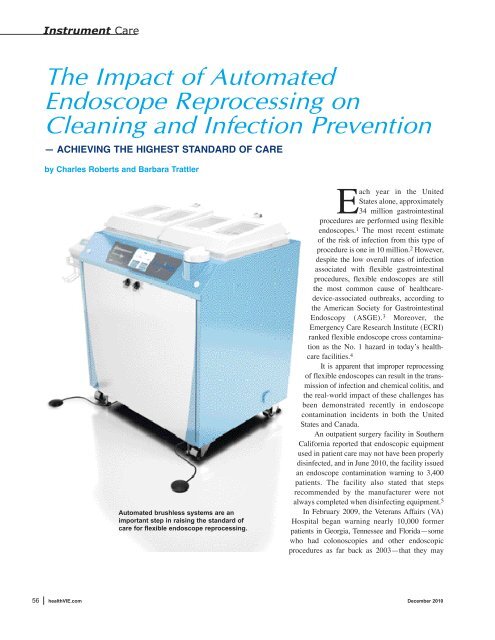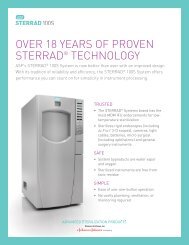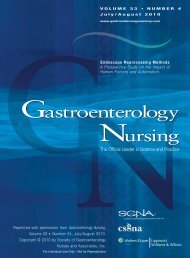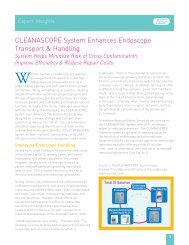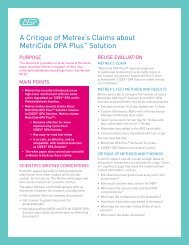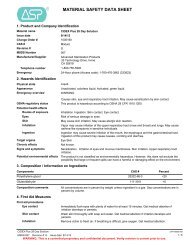The Impact of Automated Endoscope Reprocessing on Cleaning ...
The Impact of Automated Endoscope Reprocessing on Cleaning ...
The Impact of Automated Endoscope Reprocessing on Cleaning ...
Create successful ePaper yourself
Turn your PDF publications into a flip-book with our unique Google optimized e-Paper software.
Instrument Care<br />
<str<strong>on</strong>g>The</str<strong>on</strong>g> <str<strong>on</strong>g>Impact</str<strong>on</strong>g> <str<strong>on</strong>g>of</str<strong>on</strong>g> <str<strong>on</strong>g>Automated</str<strong>on</strong>g><br />
<str<strong>on</strong>g>Endoscope</str<strong>on</strong>g> <str<strong>on</strong>g>Reprocessing</str<strong>on</strong>g> <strong>on</strong><br />
<strong>Cleaning</strong> and Infecti<strong>on</strong> Preventi<strong>on</strong><br />
— ACHIEVING THE HIGHEST STANDARD OF CARE<br />
by Charles Roberts and Barbara Trattler<br />
<str<strong>on</strong>g>Automated</str<strong>on</strong>g> brushless systems are an<br />
important step in raising the standard <str<strong>on</strong>g>of</str<strong>on</strong>g><br />
care for flexible endoscope reprocessing.<br />
Each year in the United<br />
States al<strong>on</strong>e, approximately<br />
34 milli<strong>on</strong> gastrointestinal<br />
procedures are performed using flexible<br />
endoscopes. 1 <str<strong>on</strong>g>The</str<strong>on</strong>g> most recent estimate<br />
<str<strong>on</strong>g>of</str<strong>on</strong>g> the risk <str<strong>on</strong>g>of</str<strong>on</strong>g> infecti<strong>on</strong> from this type <str<strong>on</strong>g>of</str<strong>on</strong>g><br />
procedure is <strong>on</strong>e in 10 milli<strong>on</strong>. 2 However,<br />
despite the low overall rates <str<strong>on</strong>g>of</str<strong>on</strong>g> infecti<strong>on</strong><br />
associated with flexible gastrointestinal<br />
procedures, flexible endoscopes are still<br />
the most comm<strong>on</strong> cause <str<strong>on</strong>g>of</str<strong>on</strong>g> healthcaredevice-associated<br />
outbreaks, according to<br />
the American Society for Gastrointestinal<br />
Endoscopy (ASGE). 3 Moreover, the<br />
Emergency Care Research Institute (ECRI)<br />
ranked flexible endoscope cross c<strong>on</strong>taminati<strong>on</strong><br />
as the No. 1 hazard in today’s healthcare<br />
facilities. 4<br />
It is apparent that improper reprocessing<br />
<str<strong>on</strong>g>of</str<strong>on</strong>g> flexible endoscopes can result in the transmissi<strong>on</strong><br />
<str<strong>on</strong>g>of</str<strong>on</strong>g> infecti<strong>on</strong> and chemical colitis, and<br />
the real-world impact <str<strong>on</strong>g>of</str<strong>on</strong>g> these challenges has<br />
been dem<strong>on</strong>strated recently in endoscope<br />
c<strong>on</strong>taminati<strong>on</strong> incidents in both the United<br />
States and Canada.<br />
An outpatient surgery facility in Southern<br />
California reported that endoscopic equipment<br />
used in patient care may not have been properly<br />
disinfected, and in June 2010, the facility issued<br />
an endoscope c<strong>on</strong>taminati<strong>on</strong> warning to 3,400<br />
patients. <str<strong>on</strong>g>The</str<strong>on</strong>g> facility also stated that steps<br />
recommended by the manufacturer were not<br />
always completed when disinfecting equipment. 5<br />
In February 2009, the Veterans Affairs (VA)<br />
Hospital began warning nearly 10,000 former<br />
patients in Georgia, Tennessee and Florida—some<br />
who had col<strong>on</strong>oscopies and other endoscopic<br />
procedures as far back as 2003—that they may<br />
56 healthVIE.com<br />
December 2010
Instrument Care<br />
Dr. Alfa’s data dem<strong>on</strong>strate<br />
that an automated process can<br />
provide optimal endoscope<br />
reprocessing, and give<br />
physicians and patients<br />
c<strong>on</strong>fidence that the scopes<br />
have been c<strong>on</strong>sistently cleaned.<br />
have been exposed to infecti<strong>on</strong>s, including HIV<br />
and hepatitis. 6<br />
In April <str<strong>on</strong>g>of</str<strong>on</strong>g> this year, 500 patients who underwent<br />
endoscopic retrograde cholangiopancreatography at<br />
Victoria General Hospital in Canada were issued<br />
letters warning them <str<strong>on</strong>g>of</str<strong>on</strong>g> potential bloodborne virus<br />
infecti<strong>on</strong>s. According to the hospital, a review <str<strong>on</strong>g>of</str<strong>on</strong>g><br />
endoscopes revealed residual biological material <strong>on</strong><br />
<strong>on</strong>e scope that could have resulted in the transmissi<strong>on</strong><br />
<str<strong>on</strong>g>of</str<strong>on</strong>g> infecti<strong>on</strong>. 7<br />
<str<strong>on</strong>g>The</str<strong>on</strong>g>se incidents underscore the importance <str<strong>on</strong>g>of</str<strong>on</strong>g><br />
improving the cleaning process for flexible endoscopes.<br />
Data indicate that the manual reprocessing <str<strong>on</strong>g>of</str<strong>on</strong>g><br />
flexible endoscopes may be a significant c<strong>on</strong>tributor<br />
to the challenges with the current standard <str<strong>on</strong>g>of</str<strong>on</strong>g><br />
care. Numerous studies <str<strong>on</strong>g>of</str<strong>on</strong>g> manual reprocessing<br />
indicate widespread difficulty in achieving endoscope<br />
manufacturers’ recommended standards for manual<br />
cleaning and show great variability in the manual<br />
cleaning performed. 8-14 In fact, a recent study<br />
indicates that as much as 60 percent <str<strong>on</strong>g>of</str<strong>on</strong>g> scopes may<br />
not be processed correctly. 15<br />
Additi<strong>on</strong>ally, manual endoscope reprocessing<br />
requires meticulous work that may cause strain<br />
injuries to employees and the potential human<br />
error can lead to inadequate cleaning and high-level<br />
disinfecti<strong>on</strong>. 16 In additi<strong>on</strong> to the physical demands,<br />
the need to handle high volumes <str<strong>on</strong>g>of</str<strong>on</strong>g> endoscopes with<br />
quick turnaround to avoid procedural delays can<br />
place significant stress <strong>on</strong> staff. 17<br />
<str<strong>on</strong>g>Endoscope</str<strong>on</strong>g> <strong>Cleaning</strong> and <str<strong>on</strong>g>Reprocessing</str<strong>on</strong>g><br />
In order to address some <str<strong>on</strong>g>of</str<strong>on</strong>g> the challenges<br />
with manual reprocessing, Michelle Alfa, PhD,<br />
FCCM, performed a study to assess the efficacy <str<strong>on</strong>g>of</str<strong>on</strong>g><br />
automated endoscope cleaning reprocessor for flexible<br />
58 healthVIE.com<br />
col<strong>on</strong>oscopes, duodenoscopes, gastroscopes and br<strong>on</strong>choscopes using<br />
the EVOTECH ® <str<strong>on</strong>g>Endoscope</str<strong>on</strong>g> Cleaner and Reprocessor (ECR) from<br />
Advanced Sterilizati<strong>on</strong> Products (ASP). Key results from the data<br />
indicate that the overall compliance <str<strong>on</strong>g>of</str<strong>on</strong>g> the EVOTECH ECR cleaning,<br />
with all benchmarks for surfaces and lumens, was greater than 99 percent.<br />
Published in BMC Infectious Diseases in July 2010, the article<br />
titled “EVOTECH ® <str<strong>on</strong>g>Endoscope</str<strong>on</strong>g> Cleaner and Reprocessor (ECR)<br />
Simulated-Use and Clinical-Use Evaluati<strong>on</strong> <str<strong>on</strong>g>of</str<strong>on</strong>g> <strong>Cleaning</strong> Efficacy”<br />
determined that the cleaning achieved using the EVOTECH ECR was<br />
superior to that achieved using optimal manual cleaning. In the clinicaluse<br />
study, 75 patient-used scopes were evaluated post-cleaning and 98.8<br />
percent <str<strong>on</strong>g>of</str<strong>on</strong>g> surfaces and 99.7 percent <str<strong>on</strong>g>of</str<strong>on</strong>g> lumens met or surpassed the<br />
cleaning endpoints set for protein, hemoglobin and bioburden residuals.<br />
<str<strong>on</strong>g>The</str<strong>on</strong>g> clinical-use study showed that after automated cleaning, residuals<br />
for protein, hemoglobin and bioburden in the sucti<strong>on</strong> channel (L1)<br />
were substantially better (99.7 percent met all benchmarks) compared to<br />
manual cleaning. Also, in the simulated-use study 100 percent <str<strong>on</strong>g>of</str<strong>on</strong>g> the<br />
Olympus col<strong>on</strong>oscopes, duodenoscopes and br<strong>on</strong>choscopes evaluated<br />
met or surpassed all benchmarks for protein and bioburden residuals. For<br />
all phases, cleaning efficiency was validated with bedside flushing for<br />
elective procedures, but not emergency endoscopy procedures or where<br />
more than <strong>on</strong>e hour has passed since the procedure.<br />
Raising the Standard <str<strong>on</strong>g>of</str<strong>on</strong>g> Care<br />
Dr. Alfa’s data dem<strong>on</strong>strate that an automated process can provide<br />
optimal endoscope reprocessing, and give physicians and patients<br />
c<strong>on</strong>fidence that the scopes have been c<strong>on</strong>sistently cleaned. <str<strong>on</strong>g>The</str<strong>on</strong>g> ASGE<br />
and Society <str<strong>on</strong>g>of</str<strong>on</strong>g> Gastroenterology Nurses and Associates (SGNA) have<br />
noted that automated brushless systems are an important step in raising<br />
the standard <str<strong>on</strong>g>of</str<strong>on</strong>g> care for flexible endoscope reprocessing, 18,19 and this<br />
data <str<strong>on</strong>g>of</str<strong>on</strong>g>fers support that manual cleaning <str<strong>on</strong>g>of</str<strong>on</strong>g> endoscopes is not necessary<br />
with an automated process like the EVOTECH ® ECR. Today, the reality<br />
is endoscopy departments are expected to increase the number <str<strong>on</strong>g>of</str<strong>on</strong>g><br />
December 2010
procedures performed daily with the same or sometimes less resources.<br />
Automating endoscope reprocessing can allow facilities to utilize<br />
valuable staff resources in other patient-related activities and reduce<br />
occupati<strong>on</strong>al health problems associated with reprocessing.<br />
Although there are a number <str<strong>on</strong>g>of</str<strong>on</strong>g> guidelines in place related to<br />
endoscope reprocessing, including those from the government, third<br />
parties and manufacturers, a recent study revealed that GI endoscopes<br />
were generally not reprocessed in accordance with guidelines. 20 In<br />
line with this, <strong>on</strong>ly <strong>on</strong>e <str<strong>on</strong>g>of</str<strong>on</strong>g> 69 endoscopes in the study was reprocessed<br />
properly when manual reprocessing methods were used. In c<strong>on</strong>trast,<br />
an automated endoscope cleaner and reprocessor resulted in better<br />
compliance with guidelines.<br />
As noted previously, and as recognized by the Centers for Disease<br />
C<strong>on</strong>trol (CDC), c<strong>on</strong>taminated endoscopes are the most comm<strong>on</strong> cause <str<strong>on</strong>g>of</str<strong>on</strong>g><br />
medical-device-associated healthcare outbreaks. 21 In its 2008 guideline<br />
for “Infecti<strong>on</strong> C<strong>on</strong>trol During GI Endoscopy,” the ASGE points out that<br />
the efficacy <str<strong>on</strong>g>of</str<strong>on</strong>g> the cleaning and disinfecti<strong>on</strong> processes are pers<strong>on</strong>nel<br />
dependent. Furthermore, the SGNA states that there is a “narrow margin<br />
<str<strong>on</strong>g>of</str<strong>on</strong>g> safety” in the process for flexible endoscope reprocessing and that<br />
“any slight deviati<strong>on</strong>” from the recommended protocol can lead to<br />
an increased risk <str<strong>on</strong>g>of</str<strong>on</strong>g> infecti<strong>on</strong>. To put it simply, given the potential for<br />
infecti<strong>on</strong> <str<strong>on</strong>g>of</str<strong>on</strong>g> potentially life-threatening illnesses, there is no room for<br />
human error in flexible endoscope reprocessing. For facilities striving<br />
to achieve the highest standard <str<strong>on</strong>g>of</str<strong>on</strong>g> care, automati<strong>on</strong> can standardize reprocessing<br />
procedures and eliminate human shortcomings.<br />
For More Informati<strong>on</strong><br />
1. EVOTECH ® <str<strong>on</strong>g>Endoscope</str<strong>on</strong>g> Cleaner and Reprocessor (ECR) Simulateduse<br />
and Clinical-use Evaluati<strong>on</strong> <str<strong>on</strong>g>of</str<strong>on</strong>g> <strong>Cleaning</strong> Efficacy - http://www.<br />
biomedcentral.com [http://www.biomedcentral.com/1471-2334/10/200]<br />
2. ASGE “Infecti<strong>on</strong> C<strong>on</strong>trol During GI Endoscopy” - http://www.<br />
asge.org [http://www.asge.org/uploadedFiles/Publicati<strong>on</strong>s_and_<br />
Products/Practice_Guidelines/1999_infecti<strong>on</strong>.pdf]<br />
3. SGNA “2009 <str<strong>on</strong>g>Reprocessing</str<strong>on</strong>g> <str<strong>on</strong>g>of</str<strong>on</strong>g> Endoscopic Accessories and<br />
Valves” -http://www.sgna.org [http://www.sgna.org/Resources/<br />
reprocessingvalves0509.pdf]<br />
4. Advanced Sterilizati<strong>on</strong> Products EVOTECH ® ECR - http://www.<br />
aspjj.com [http://www.aspjj.com/us/products/evotech-ecr/publicati<strong>on</strong>]✛<br />
References<br />
1. American Society <str<strong>on</strong>g>of</str<strong>on</strong>g> Gastrointestinal Endoscopy Web site: http://www.asge.org/<br />
PressroomIndex.aspx?id=6858. Accessed 9 October 2009.<br />
2. Nels<strong>on</strong> DB, Muscarella LF. Current Issues in <str<strong>on</strong>g>Endoscope</str<strong>on</strong>g> <str<strong>on</strong>g>Reprocessing</str<strong>on</strong>g> and<br />
Infecti<strong>on</strong> C<strong>on</strong>trol during Gastrointestinal Endoscopy. World Journal <str<strong>on</strong>g>of</str<strong>on</strong>g><br />
Gastroenterology. 2006;12:3593-964.<br />
3. Gillespie EE, Kotsanas D, Stuart RL. Microbiological M<strong>on</strong>itoring <str<strong>on</strong>g>of</str<strong>on</strong>g><br />
<str<strong>on</strong>g>Endoscope</str<strong>on</strong>g>s: 5-year review. J Gastroenterol Hepatol. 2008;23(7 Pt 1):1069-74.<br />
4. Ford O. C<strong>on</strong>taminated <str<strong>on</strong>g>Endoscope</str<strong>on</strong>g>s Top ECRI’s Hazard List. Medical Device<br />
Daily. 12 August 2010.<br />
5. Clark C. Hospital Sends Letters to 3,400 Patients about Possible Endoscopic<br />
Equipment C<strong>on</strong>taminati<strong>on</strong>. HealthLeaders. 16 June 2010.<br />
6. Department <str<strong>on</strong>g>of</str<strong>on</strong>g> Veterans Affairs Office <str<strong>on</strong>g>of</str<strong>on</strong>g> Inspector General. Healthcare<br />
Inspecti<strong>on</strong> Use and <str<strong>on</strong>g>Reprocessing</str<strong>on</strong>g> <str<strong>on</strong>g>of</str<strong>on</strong>g> Flexible Fiberoptic <str<strong>on</strong>g>Endoscope</str<strong>on</strong>g>s at VA<br />
Medical Facilities. Report No. 09-01784-146. 16 June 2009.<br />
7. 500 Vancouver Island Patients Warned <str<strong>on</strong>g>of</str<strong>on</strong>g> Possible Infecti<strong>on</strong> from Dirty<br />
<str<strong>on</strong>g>Endoscope</str<strong>on</strong>g>s. <str<strong>on</strong>g>The</str<strong>on</strong>g> Vancouver Sun. 22 April 2010. http://www.vancouversun.com/<br />
Instrument Care<br />
opini<strong>on</strong>/Vancouver+Island+patients+warned+possible+<br />
infecti<strong>on</strong>+from+dirty+endoscopes/2939673/story.html.<br />
Accessed 7 September 2010.<br />
8. Gillespie EE, Kotsanas D, Stuart RL. Microbiological<br />
M<strong>on</strong>itoring <str<strong>on</strong>g>of</str<strong>on</strong>g> <str<strong>on</strong>g>Endoscope</str<strong>on</strong>g>s: 5-year review. J Gastroenterol<br />
Hepatol. 2008;23(7 Pt 1):1069-74.<br />
9. Bisset L, Cossart YE, Selby W, et al. A Prospective Study<br />
<str<strong>on</strong>g>of</str<strong>on</strong>g> the Efficacy <str<strong>on</strong>g>of</str<strong>on</strong>g> Routine Dec<strong>on</strong>taminati<strong>on</strong> for<br />
Gastrointestinal <str<strong>on</strong>g>Endoscope</str<strong>on</strong>g>s and the Risk Factors for<br />
Failure. Am J Infect C<strong>on</strong>trol. 2006;34(5):274-80.<br />
10. Moses FM, Lee JS. Current GI <str<strong>on</strong>g>Endoscope</str<strong>on</strong>g> Disinfecti<strong>on</strong><br />
and QA Practices. Dig Dis Sci. 2004;49(11-12):1791-7.<br />
11. Alfa MJ, Howie R. Modeling Microbial Survival in<br />
Buildup Bi<str<strong>on</strong>g>of</str<strong>on</strong>g>ilm for Complex Medical Devices. BMC<br />
Iinfect Dis. 2009;9:56.<br />
12. Vickery K, Pajkos A, Cossart Y. Removal <str<strong>on</strong>g>of</str<strong>on</strong>g> Bi<str<strong>on</strong>g>of</str<strong>on</strong>g>ilm from<br />
<str<strong>on</strong>g>Endoscope</str<strong>on</strong>g>s: Evaluati<strong>on</strong> <str<strong>on</strong>g>of</str<strong>on</strong>g> Detergent Efficiency. Am J<br />
Infect C<strong>on</strong>trol. 2004;32(3):170-6.<br />
13. Vickery K, Quan-D N, Zou J, Cossart Y. <str<strong>on</strong>g>The</str<strong>on</strong>g> Effect <str<strong>on</strong>g>of</str<strong>on</strong>g><br />
Multiple Cycles <str<strong>on</strong>g>of</str<strong>on</strong>g> C<strong>on</strong>taminati<strong>on</strong>, Detergent Washing<br />
and Disinfecti<strong>on</strong> <strong>on</strong> the Development <str<strong>on</strong>g>of</str<strong>on</strong>g> Bi<str<strong>on</strong>g>of</str<strong>on</strong>g>ilm in<br />
<str<strong>on</strong>g>Endoscope</str<strong>on</strong>g> Tubing. Am J Infect C<strong>on</strong>trol. 2009.<br />
14. Mari<strong>on</strong> K, Freney J, James G, Berger<strong>on</strong> E, Renaud FN,<br />
Costert<strong>on</strong> JW. Using an Efficient Bi<str<strong>on</strong>g>of</str<strong>on</strong>g>ilm Detaching<br />
Agent: an Essential Step for the improvement <str<strong>on</strong>g>of</str<strong>on</strong>g> <str<strong>on</strong>g>Endoscope</str<strong>on</strong>g><br />
<str<strong>on</strong>g>Reprocessing</str<strong>on</strong>g> Protocols. J <str<strong>on</strong>g>of</str<strong>on</strong>g> Hosp Infect. 2006;64(2):<br />
136-42.<br />
15. Data <strong>on</strong> file, Advanced Sterilizati<strong>on</strong> Products.<br />
16. Ofstead C, Wetzler H, Snyder A, Hort<strong>on</strong>, R. <str<strong>on</strong>g>Endoscope</str<strong>on</strong>g><br />
<str<strong>on</strong>g>Reprocessing</str<strong>on</strong>g> Methods. Gastroenterology Nursing. 2010:<br />
33(4): 304-311.<br />
17. Dix K. Scope Leak Testing. EndoNurse. 30 March 2007.<br />
http://www.end<strong>on</strong>urse.com/articles/2007/03/scope-leaktesting.aspx<br />
Accessed 7 September 2010.<br />
18. ASGE, Infecti<strong>on</strong> C<strong>on</strong>trol During GI Endoscopy, 2008.<br />
19. SGNA, Standards <str<strong>on</strong>g>of</str<strong>on</strong>g> Infecti<strong>on</strong> C<strong>on</strong>trol in <str<strong>on</strong>g>Reprocessing</str<strong>on</strong>g> <str<strong>on</strong>g>of</str<strong>on</strong>g><br />
Flexible Gastrointestinal <str<strong>on</strong>g>Endoscope</str<strong>on</strong>g>s, 2008.<br />
20. Ofstead et al.<br />
21. CDC, Guideline for Disinfecti<strong>on</strong> and Sterilizati<strong>on</strong> in<br />
Healthcare Facilities, 2008. AD-100324-01-US_A<br />
Charles Roberts is director <str<strong>on</strong>g>of</str<strong>on</strong>g> research, microbiology<br />
and chemistry for Advanced Sterilizati<strong>on</strong><br />
Products. He has more than 25 years <str<strong>on</strong>g>of</str<strong>on</strong>g> experience in<br />
both quality assurance for major medical device<br />
companies and research and development. Mr.<br />
Roberts has published numerous papers in scientific<br />
literature and made over 40 presentati<strong>on</strong>s at scientific<br />
meetings <strong>on</strong> sterilizati<strong>on</strong>, disinfecti<strong>on</strong> and<br />
microbiological topics.<br />
Barbara Trattler is director <str<strong>on</strong>g>of</str<strong>on</strong>g> clinical educati<strong>on</strong><br />
for Advanced Sterilizati<strong>on</strong> Products. Ms. Trattler has<br />
more than 25 years experience in perioperative<br />
nursing practice and has held various clinical and<br />
administrative positi<strong>on</strong>s in academic and community<br />
hospitals. Ms. Trattler is certified in perioperative<br />
nursing and nursing administrati<strong>on</strong> and has lectured<br />
extensively <strong>on</strong> healthcare-related topics.<br />
Copyright©2010-2011/TKMK Media L.L.C./All Rights Reseved. Reprint with permissi<strong>on</strong> from TKMK Media L.L.C.<br />
December 2010 healthVIE.com<br />
59


